Effective communication and personal change are essential skills in today’s fast-paced world. Neuro-Linguistic Programming (NLP) offers practical methods like active listening, mirroring, and reframing. These techniques enhance interpersonal skills and promote personal development. Additionally, understanding cultural contexts and avoiding common pitfalls can maximize the impact of NLP strategies.
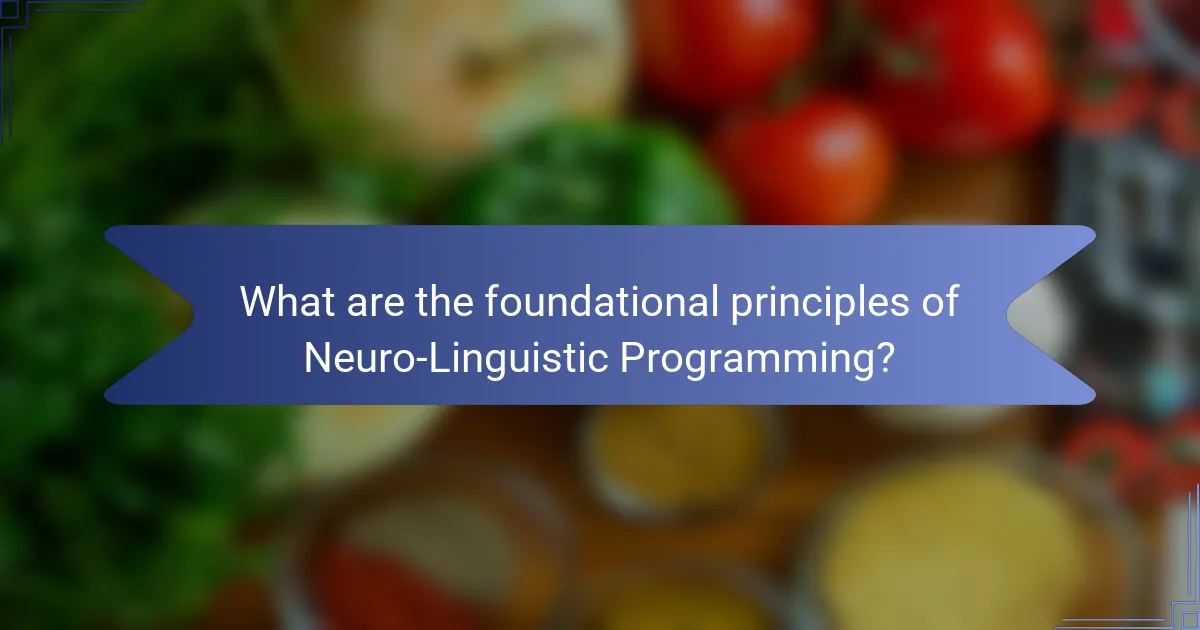
What are the foundational principles of Neuro-Linguistic Programming?
The foundational principles of Neuro-Linguistic Programming (NLP) focus on understanding and enhancing communication and personal change. Key principles include the idea that subjective experience shapes behaviour, the importance of modelling successful behaviours, and the belief that individuals possess the resources for change. NLP emphasizes the connection between neurological processes, language, and behavioural patterns, allowing for effective strategies in personal development and communication.
How does NLP influence communication styles?
NLP significantly enhances communication styles by promoting clarity, empathy, and adaptability. It equips individuals with techniques to understand and respond to others effectively, fostering better interpersonal connections.
NLP methods, such as mirroring and reframing, help adjust communication to suit different audiences. These techniques enhance rapport and ensure messages resonate. For example, using positive language can shift perceptions and motivate change.
By recognizing different communication styles, NLP allows for tailored interactions. This adaptability leads to more effective persuasion and conflict resolution. Ultimately, NLP transforms communication into a dynamic and responsive process, improving personal and professional relationships.
What role does perception play in NLP?
Perception plays a crucial role in Neuro-Linguistic Programming (NLP) by shaping how individuals interpret experiences. It influences communication effectiveness and personal change by determining responses to stimuli. Understanding perception allows practitioners to tailor their approaches, fostering better connections and outcomes. Perception also affects the interpretation of language, impacting the meaning derived from words and gestures. This understanding enhances the application of NLP methods, leading to more effective communication strategies and personal transformations.

What are the universal techniques in NLP for effective communication?
Neuro-Linguistic Programming (NLP) employs several universal techniques for effective communication. These methods enhance interpersonal skills, promote understanding, and facilitate personal change.
Active listening is a foundational technique in NLP, allowing individuals to fully engage with others and comprehend their perspectives. This practice fosters empathy and builds rapport.
Mirroring is another key method, where one subtly mimics the body language and speech patterns of their conversation partner. This creates a sense of connection and can enhance the effectiveness of communication.
Reframing involves altering the perception of a situation to change its meaning. This technique empowers individuals to view challenges as opportunities, promoting a positive mindset.
Anchoring is a unique NLP technique that connects specific emotional states with stimuli, such as words or gestures. This allows individuals to access desired emotional states during communication, enhancing clarity and confidence.
How can anchoring be used to enhance communication?
Anchoring enhances communication by creating mental associations that influence responses. This technique allows individuals to connect specific stimuli with desired emotional states or reactions, improving rapport and clarity. For example, using a consistent gesture or phrase can trigger positive feelings, making interactions more effective. By leveraging this unique attribute of anchoring, communicators can foster trust and engagement, leading to more impactful exchanges.
What steps are involved in creating effective anchors?
Creating effective anchors involves several key steps that enhance communication and promote personal change.
1. Identify the desired outcome: Clearly define what you want to achieve with the anchor.
2. Choose a specific trigger: Select a stimulus, such as a word or gesture, that will evoke the desired emotional or mental state.
3. Establish the anchor: Use the chosen trigger in conjunction with the desired state during practice sessions to reinforce the connection.
4. Test and refine: Evaluate the effectiveness of the anchor in real situations and make adjustments as necessary to strengthen its impact.
What is the significance of mirroring in NLP?
Mirroring in NLP is significant as it enhances rapport and facilitates effective communication. By mimicking another person’s body language, tone, or speech patterns, individuals can create a sense of trust and understanding. This technique, rooted in the principles of Neuro-Linguistic Programming, helps in establishing a connection that can lead to positive personal change. For example, when a therapist mirrors a client’s gestures, it can promote a more open dialogue and deeper emotional engagement. This unique attribute of mirroring makes it a powerful tool in various interpersonal interactions.
How can mirroring improve rapport?
Mirroring can significantly enhance rapport by fostering a sense of connection and understanding. This technique, rooted in neuro-linguistic programming, involves subtly mimicking another person’s body language, speech patterns, or emotions. As a result, individuals may feel more at ease and open in communication, leading to improved interactions. Mirroring creates a subconscious bond, making the other person feel validated and understood, which is essential for effective communication.
What are the key language patterns in NLP?
Key language patterns in NLP include rapport building, sensory language, and presuppositions. These patterns enhance communication and facilitate personal change. Rapport building involves matching and mirroring body language and speech patterns to create connection. Sensory language engages the five senses, making communication more vivid and relatable. Presuppositions are assumptions embedded in language that guide thoughts and behaviours, influencing perceptions and decisions. By mastering these patterns, individuals can improve their effectiveness in interpersonal interactions.
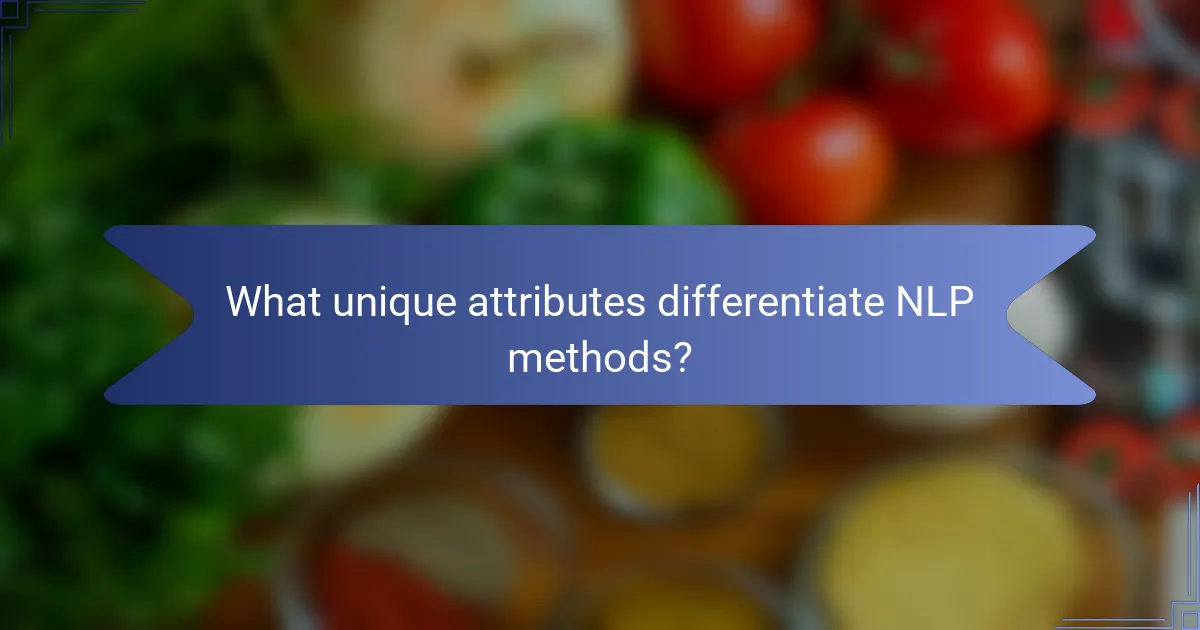
What unique attributes differentiate NLP methods?
NLP methods are differentiated by their unique attributes such as sensory acuity, representational systems, and anchoring techniques. Sensory acuity enhances awareness of non-verbal cues, improving communication. Representational systems categorize how individuals process information, influencing their responses. Anchoring techniques create associations between stimuli and emotional states, facilitating personal change.
How do submodalities affect personal change?
Submodalities significantly influence personal change by altering perceptions and behaviours. They are the specific qualities of our sensory experiences, such as visual, auditory, and kinesthetic elements. By adjusting these submodalities, individuals can reshape their emotional responses and beliefs. For example, changing the brightness of a mental image can lessen its emotional impact, facilitating a more positive mindset. This technique is central to Neuro-Linguistic Programming, enabling effective communication and personal transformation.
What are the common submodalities used in NLP?
Common submodalities used in NLP include visual, auditory, and kinesthetic distinctions. These submodalities shape how individuals perceive experiences and communicate effectively.
Visual submodalities involve attributes like brightness, size, and colour, influencing how one visualizes information. Auditory submodalities encompass volume, pitch, and tempo, affecting how sounds are interpreted. Kinesthetic submodalities relate to feelings of pressure, temperature, and movement, impacting emotional responses.
Understanding these submodalities enhances personal change and communication skills, allowing for tailored approaches in various contexts.
How does reframing contribute to personal transformation?
Reframing significantly enhances personal transformation by shifting perspectives and altering interpretations of experiences. This technique allows individuals to view challenges as opportunities, fostering resilience and adaptability. By changing the narrative, reframing can unlock new pathways for growth and self-improvement. This unique attribute of reframing makes it a powerful tool in neuro-linguistic programming, facilitating effective communication and personal change.
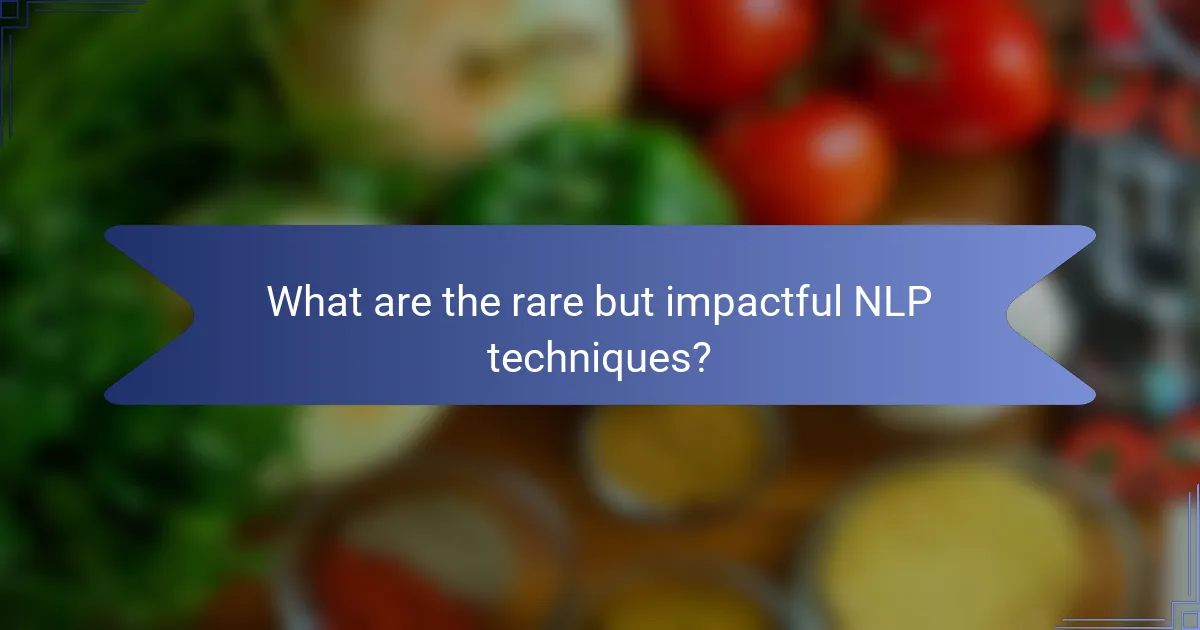
What are the rare but impactful NLP techniques?
Rare but impactful NLP techniques include pattern interruption, anchoring, and reframing. These methods enhance communication and facilitate personal change.
Pattern interruption disrupts habitual thought processes, allowing for new perspectives. This technique can be particularly effective in breaking negative cycles. Anchoring involves associating emotional states with specific stimuli, helping individuals access desired feelings on demand. Reframing shifts perception by altering the context of a situation, leading to different emotional responses and behaviours.
These techniques, while less commonly discussed, offer significant benefits for personal development and effective communication.
What is the role of timeline therapy in personal change?
Timeline therapy plays a crucial role in personal change by helping individuals reframe past experiences and alter their emotional responses. This NLP method allows clients to visualize their life events along a timeline, facilitating a deeper understanding of how these events shape current behaviours and beliefs. By addressing negative emotions associated with past experiences, individuals can release limiting beliefs and foster positive change. This therapeutic approach not only aids in healing but also empowers individuals to create a desired future, making it a unique tool in personal transformation.
How can advanced metaphor techniques enhance communication?
Advanced metaphor techniques can significantly enhance communication by making complex ideas more relatable and understandable. These techniques allow individuals to express abstract concepts through vivid imagery, facilitating deeper connections with their audience. For instance, metaphors can simplify intricate ideas, making them accessible and memorable. By employing metaphors, communicators can evoke emotions and foster empathy, which are essential for effective interpersonal interactions. This approach aligns with Neuro-Linguistic Programming principles, emphasizing the importance of language in shaping perceptions and facilitating personal change.
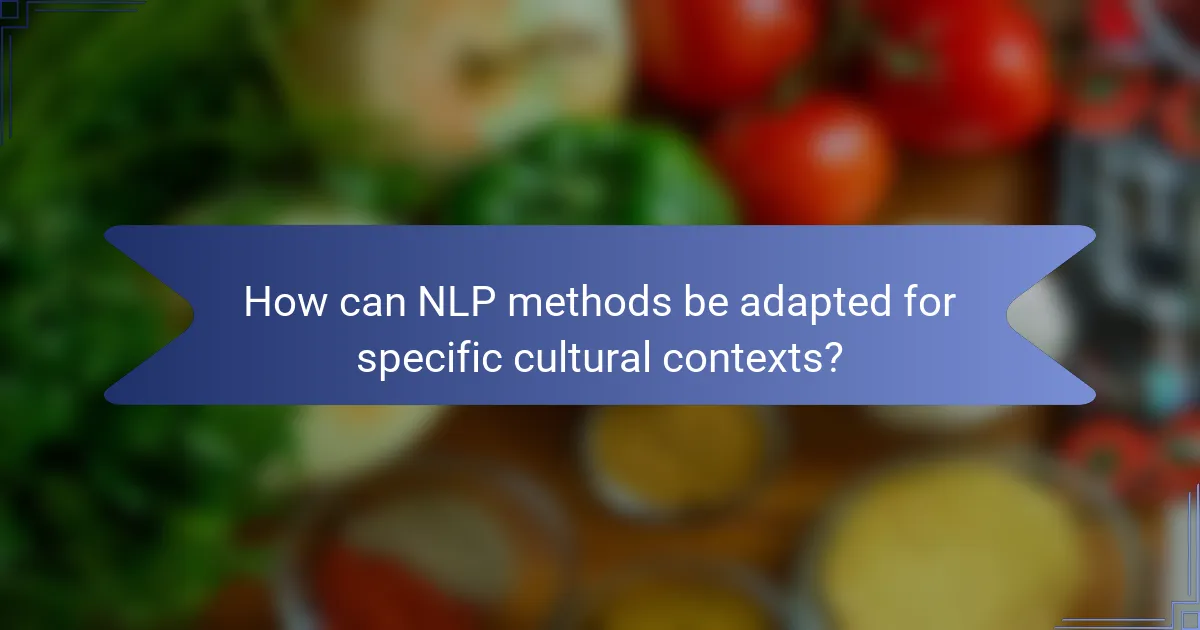
How can NLP methods be adapted for specific cultural contexts?
NLP methods can be effectively adapted for specific cultural contexts by incorporating local language nuances and social norms. Understanding cultural values enhances communication and personal change processes. Tailoring techniques like reframing and anchoring to resonate with cultural beliefs fosters deeper connections. Additionally, training practitioners in cultural sensitivity ensures that NLP applications are respectful and relevant. Using culturally appropriate metaphors and examples can also increase engagement and effectiveness.
What are the best practices for implementing NLP in diverse environments?
Implementing NLP in diverse environments requires a tailored approach that respects cultural nuances. Key practices include fostering an inclusive atmosphere, adapting communication styles, and utilizing feedback loops. Engaging stakeholders ensures relevance and effectiveness across varied contexts. Regular training on NLP techniques enhances adaptability, promoting personal change and effective communication.
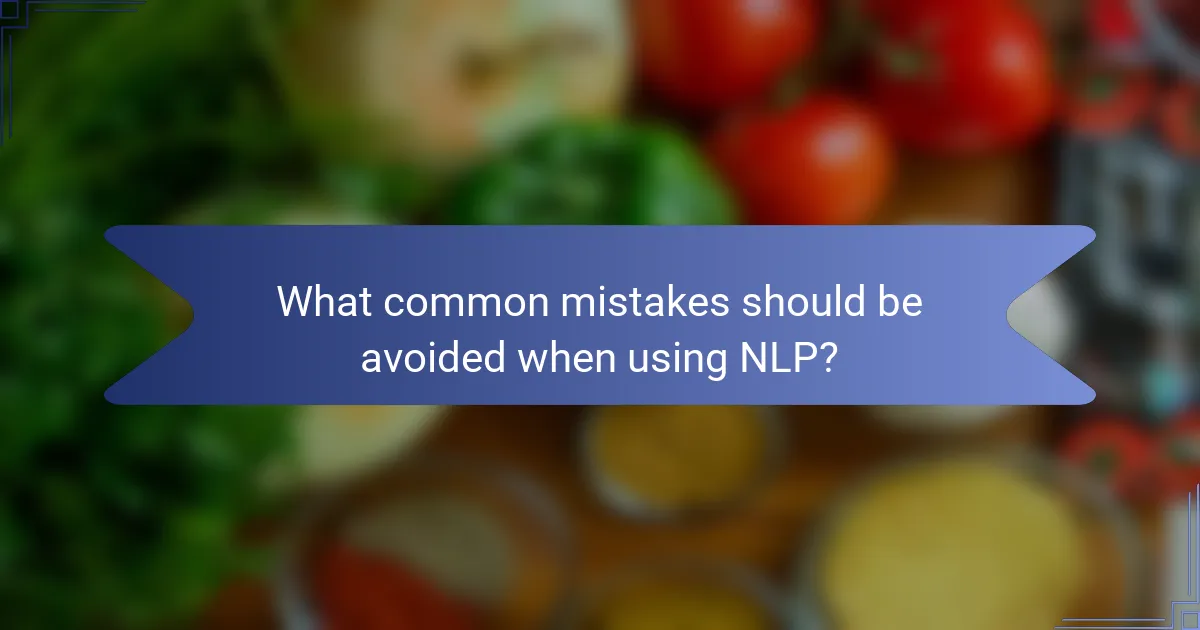
What common mistakes should be avoided when using NLP?
Common mistakes to avoid when using Neuro-Linguistic Programming include overgeneralization, neglecting context, and misapplying techniques. Overgeneralization occurs when practitioners assume strategies work universally without considering individual differences. Neglecting context can lead to inappropriate application, as the effectiveness of NLP methods often depends on the specific situation. Misapplying techniques, such as using language patterns without understanding their purpose, can result in ineffective communication. Being aware of these pitfalls enhances the effectiveness of NLP methods for personal change and communication.
How can one optimize their NLP techniques for better results?
To optimize NLP techniques for better results, focus on enhancing communication skills and personal change strategies. Key methods include active listening, mirroring body language, and utilizing positive language patterns. These practices improve rapport and understanding, leading to more effective interactions. Additionally, setting clear goals and employing visualization techniques can significantly enhance personal development outcomes. Regularly practicing these methods will deepen your mastery of NLP techniques.
What expert insights can enhance understanding of NLP methods?
Expert insights into NLP methods emphasize their ability to facilitate effective communication and personal change. Practitioners highlight the significance of understanding language patterns, which can influence perceptions and behaviours. Techniques such as anchoring and reframing are often cited for their effectiveness in altering emotional responses. Additionally, the role of rapport in communication is crucial; establishing a connection can enhance receptivity and understanding. These insights reflect the unique attribute of NLP methods in transforming interpersonal dynamics and fostering personal growth.